DIY Dog Runs: Free Plans & Blueprints For Dog Kennels & Runs
All dogs – from the most athletic greyhounds to the laziest bulldogs – need the chance to stretch their legs, run around, and get some exercise on a daily basis. In fact, adequate exercise isn’t only important for the physical health of dogs, it’s important for their mental and emotional well-being too.
However, in the real world, many owners struggle to accommodate this need. Fencing in a backyard is often prohibitively expensive, and daily trips to the dog park aren’t realistic for many owners.
But fortunately, there is a solution: You can build your pet a dog run, which will give your dog a safe place to zoom around to his heart’s content. We’ll explain more about dog runs, provide a few design tips, and share a few specific DIY plans below.
Mục Lục
What Is a Dog Run?
The term “dog run” means different things to different people, and people apply the term to several different types of areas and structures.
There doesn’t appear to be an official definition for the term, and your dog doesn’t care what you call it, so we’ll just use “dog run” to describe any type of outdoor structure or area that gives your dog space to run around.
But it is important to note that all dog runs have one very important characteristic in common – they don’t require you to supervise your dog while in use.
Dog runs are designed to keep your dog in your yard without the use of a standard perimeter fence, preventing your pup from running away or getting into excessive amounts of mischief while he gets his daily exercise.
Different Types of Dog Runs + How to Build Them: The Basics
There may not be a concrete definition for the term dog run, but most fall into one of four basic categories. Before deciding on a specific set of plans, you’ll want to familiarize yourself with each.
1. Narrow Fenced Enclosure
When most people use the term dog run, they are probably thinking of a long, narrow fenced area which allows your dog to, well, run back and forth along its length.
While these types of dog runs may not give your dog the freedom to run in any direction he chooses, they provide him a long straightaway that lets him run enough to reach top speed.
2. Outdoor Kennel or Pen
Some dog runs feature a square (or nearly square) footprint that provides your dog with a place to hang out and enjoy some fresh air – think of them as outdoor playpens.
While many of these kennels or pens are too small to allow your dog to run very fast, large versions will allow your dog to run around like a proper goofball.
How to Build a Fenced Enclosure (Narrow or Square):
Whether you want to build a long and narrow dog run or a square-shaped play space for your pet, the basic steps are the same.
- Start by marking the perimeter of the area you wish to enclose
- Dig an 18- to 24-inch-deep trench along the entire perimeter.
- Dig post holes at 4- to 8-foot intervals along the trench for the vertical supports.
- Install and cement the vertical supports in place.
- Attach the fencing to the vertical supports.
You’ll also need to install a gate that provides access to the run. Experienced builders can fashion a custom gate relatively easily, but most dog owners will find it simpler to just purchase a pre-fabricated gate at the local hardware store.
You may want to add a suitable ground cover, such as hardwood mulch chips, to the dog run. Dog-safe mulch offers some terrain variety and can alleviate some of the maintenance work needed to keep up with grass. Some owners may also wish to add a roof or windshield to help protect your pup from the elements.
3. Anchored Tether
Some owners use the term dog run to apply to an open space which doesn’t feature a fence at all. Instead, a long piece of rope or chain is used to keep your dog from wandering off.
These are the easiest dog runs to build, but they don’t provide as much safety as some of the other types of dog runs.
How to Install an Anchored Tether:
An anchored tether is exceedingly easy to set up. You can simply buy a corkscrew-shaped stake, drive it into the ground, and then use a long tether to connect the stake to your dog’s collar or harness.
Just be sure to put the tether in a wide-open space which doesn’t present any hazards or obstacles to your dog (you don’t want your dog to wrap the tether around a tree, for example).
If a ground stake isn’t a good fit for your property, dog, or aesthetic tastes, you can insert a large wooden timber into the ground and cement it into place. Then, you’ll need to attach a thick steel ring to one side of the post. This will give you a place to attach the tether.
4. Sliding Tether
Some dog runs rely on a sliding (rather than fixed) tether to keep your dog from running away.
These types of dog runs are slightly trickier to build than those featuring anchored tethers, but when properly designed, your dog will be able to enjoy a long straightaway that’ll allow him to hit Mach 1.
How to Install a Sliding Tether:
A sliding tether is usually easier to set up than a fenced enclosure, but it is more complicated than setting up an anchored tether.
To start, you’ll need to suspend a long cable or rope about 6 to 10 feet above the ground. This rope should extend over the entire length of the dog run area.
You’ll then need to thread a metal ring or short piece of pipe around the suspended line. A tether can then be used to connect your dog to the sliding ring or pipe.
DIY Dog Run Plans & Examples
Most dog runs need to be custom built to suit your dog and property. However, that doesn’t mean you have to completely reinvent the wheel – check out the plans listed below and tweak them to suit your situation.
1. Shaded Dog Run by DIY Network
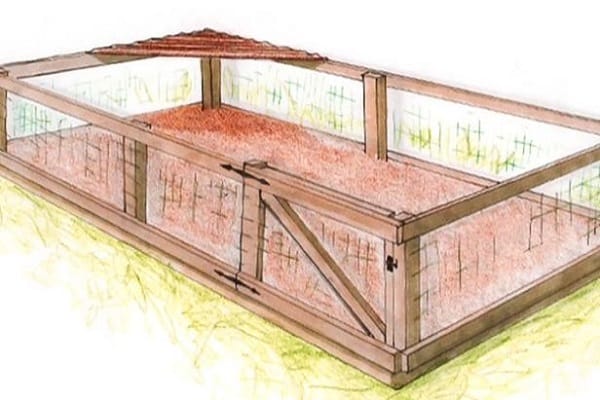
The DIY Network provides a detailed set of plans for building a spacious dog run that features a built-in shaded area.
This is a great dog run for small- to medium-sized dogs, but it probably isn’t tall enough to keep large dogs (or impressive leapers) safely contained.
Difficulty Level: Moderate to difficult
Materials Needed:
- Gravel
- 4×4 pressure-treated posts
- 2 x 2s
- Pressure-treated 2 x 4s
- Pressure-treated 2 x 6s
- Landscape timbers
- Landscape fabric
- Anti-bacterial rubber floor mat
- 3″ galvanized screws
- Plastic-coated wire fencing
- Corrugated vinyl
Tools Needed:
- Sledgehammer
- Cordless drill
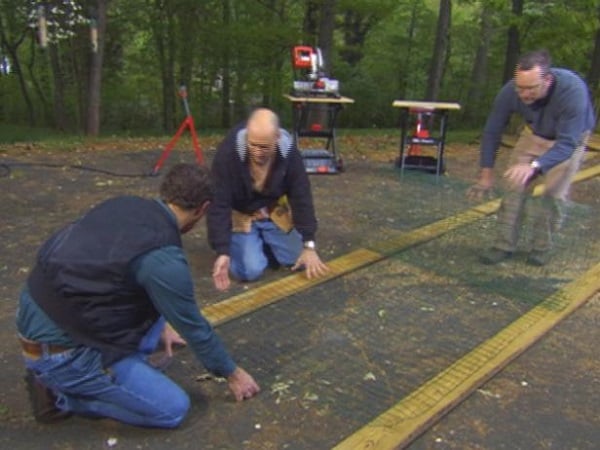
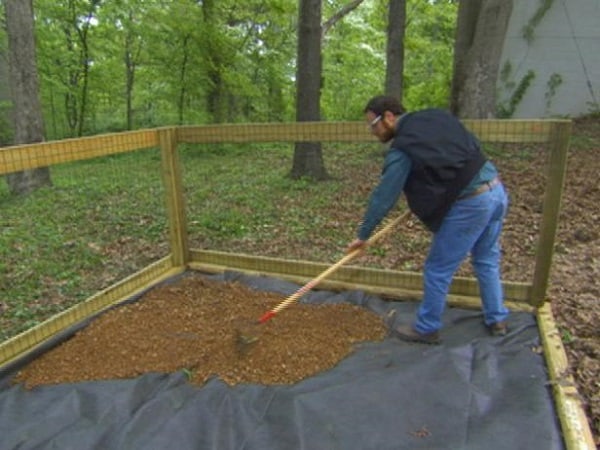
2. Cheap and Easy Dog Run by Instructables
These Cheap and Easy Dog Run plans by Instructables are some of the easiest and most affordable dog run plans we found, and they rely on a number of salvaged items that the authors had laying around.
This doesn’t appear to be a particularly escape-proof dog run, so you’ll want to think twice before using this design for Houdini-like hounds.
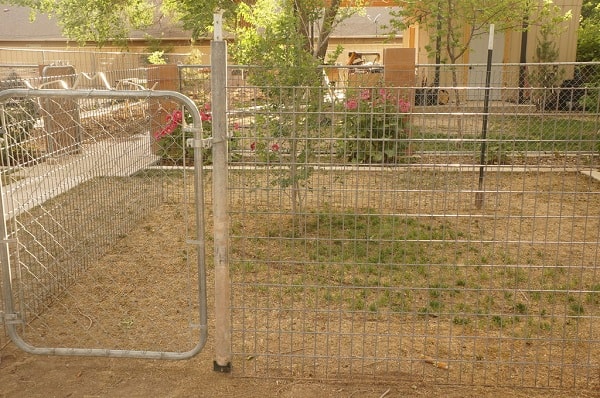
Difficulty Level: Moderate
Materials Needed:
- Heavy gauge wire livestock panels
- Aluminum wire
- Standard chain link fence gate hinges
- Old metal gate
- Metal T fence post
- 9 safety latches or clamps
- Machine oil
Tools Needed:
- 4-pound sledgehammer
- Pliers
- Tape measure
- Reciprocating saw
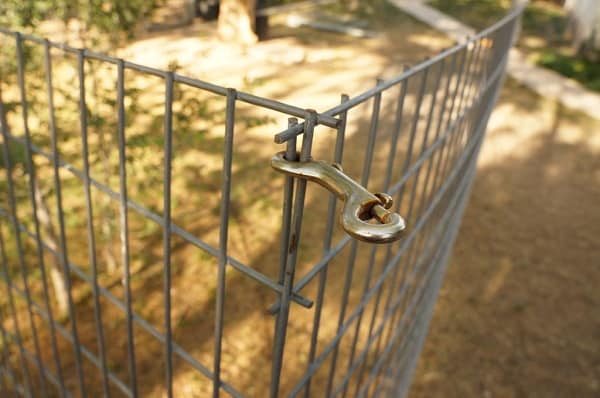
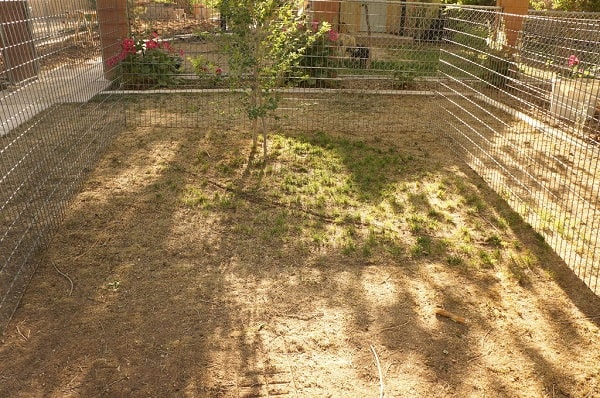
3. Chain-Link Dog Run by Family Handyman
This Chain-Link Dog Run by Family Handyman is probably my favorite set of dog run plans as it includes a variety of cool features, such as buried barriers to prevent your dog from digging his way to freedom and a place that allows you to flush-mount your dog’s house.
However, these things also make the run more challenging to build than many of the others listed here.
Difficulty Level: Difficult
Materials Needed:
- Chain link fencing and gate
- Concrete
- Landscape fabric
- Pea gravel
- Privacy slats
- Sand
- Sunscreen and/or dog house
- Treated 2x12s
Tools Needed:
- Adjustable wrench
- Circular saw
- Hacksaw
- Level
- Lineman’s pliers
- Post hole digger
- Spade
- Tape measure
- Wheelbarrow
- Shovel
- Gloves
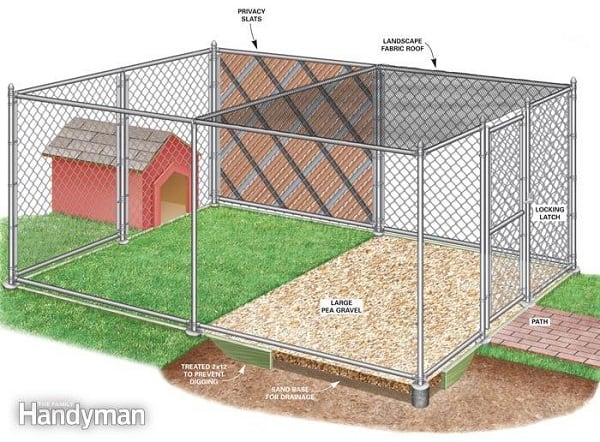
4. DIY Cable Run by Jenna & Snickers
These DIY plans from Jenna & Snickers will help you make a cable run (sliding tether) that will give your dog quite a bit of room to run without the need for a fence.
These are some of the simplest plans for a dog run we found, and they should be very helpful for owners who lack the interest or skill necessary to construct a fenced dog run.
Difficulty Level: Easy
Materials Needed:
- Galvanized steel cable
- Several chain rope clips
- Two wire rope thimbles
- Two eye bolt screws
- One swivel pulley
- Vinyl coated tie-out cable
Tools Needed:
- Hammer
- Screwdriver
- Ladder
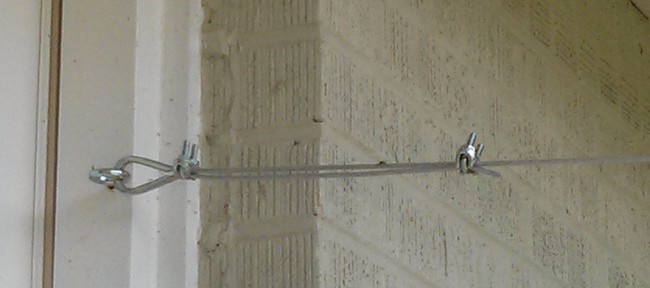

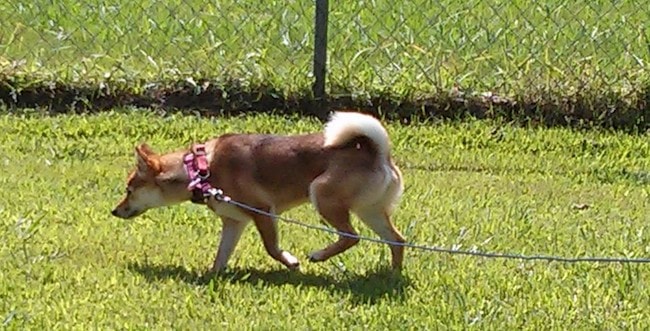
5. DIY Outdoor Kennel by Youtuber Pete B.
If you just want a simple, easy-to-build dog run, many of the ones previously discussed will fit the bill perfectly.
However, some owners want to go above-and-beyond in an effort to give their dog the most luxurious accommodations possible. And if this sounds like you, this video guide by Youtuber Pete B. will certainly help.
Now, let’s be clear: This is a HUGE project that’ll likely require more time, skill, and funding than the average dog owner is willing or able to invest. But if you want to give your pet a palatial dog run, this video will get you off to a good start.
Alternatively, it is possible to purchase sophisticated outdoor dog kennels like the one demo-ed here. They’ll cost a pretty penny, but they’ll save you a lot of time, effort, and may not even be that much more expensive when you consider supply costs.
Difficulty Level: Difficult
Materials Needed:
You’ll have to watch the video to see all of the materials Pete uses to make his run, but a few of the basic materials needed include:
- Chain-link fencing
- Chain-link gate
- Several 4 x 4 posts to serve as vertical supports
- Several 2 x 6 posts to serve as the frame for the gate
- Several 1 x 4 planks to serve as horizontal supports for the fence
- Assorted hardware
- Wood chips
Tools Needed:
- Circular saw or table saw
- Cordless drill
- Post hole digger or auger
- Mallet or post driver
- Shovel
6. Outdoor Dog Kennel by Red Brand
Red Brand (a company that makes fencing products) provides a great video guide for building a large dog run.
This is not as elaborate as the run described above, but it is still a very nice dog run. And because it is a little simpler than Pete B.’s version, it’ll be easier for most owners to construct.
Difficulty Level: Moderate to Difficult
Materials Needed:
Red Brand doesn’t provide a clear materials list for this project, so you’ll just need to follow along with the video. However, some of the things you’ll need include:
- Red Brand fencing (or similar alternative)
- Several 4 x 4s to serve as vertical supports
- Several 2 x 4s to serve as horizontal supports
- Chain-link fence gate
- Assorted hardware
Tools Needed:
- Circular saw or table saw
- Post driver or sledgehammer
- Tape measure
- Post hole digger
- Cordless drill
- Plumb bob
Note that this video is divided into two parts.
Important Considerations: Is a Dog Run Right for Your Pet?
Now that you understand the basic options available, you can begin trying to decide whether one is right for you, and, if so, which type you want to build.
Each type of dog run presents a different collection of benefits and drawbacks you’ll want to consider when making your choice.
Dog Runs May Damage Your Lawn
If you allow your dog to run, jump, and play in the same place day after day, your lawn will likely start to show signs of damage. You can, however, do a few things to mitigate or avoid this problem:
- Make the dog run as big as possible to spread out the damage your dog causes.
- Cover the area with wood chips or some other paw-friendly material (the grass will still die, but it will look better). Also consider using a dog-friendly grass in your yard that’s a bit tougher than the average yard seed.
- Pave the area with concrete (just be sure to give your dog a few comfortable places to lay down).
- Move your dog’s tether around periodically to spread out the wear and tear.
Of course, you may not care if your dog tears up the lawn if the run is situated in an inconspicuous location. However, dogs who run around on bare dirt will tend to need more frequent baths than those who play on grass.
Unfenced Dog Runs Leave Your Pet Exposed to External Threats
While a tether-style dog run will usually prevent your dog from wandering off, it won’t protect him from external threats.
This not only includes things like feral or unleashed dogs, but coyotes and other predators too. And, although it sounds like something that only a supervillain in a movie would do, some people may even try to steal your dog.

Small dogs are obviously much more vulnerable to these types of dangers than big dogs, but that doesn’t mean big dogs are immune to these threats. A group of canines could gang up on your pet, and nefarious people may harm your pooch in a number of ways – no matter how big and scary he is.
There’s not much you can do to protect tethered dogs from these kinds of threats, so just be sure to carefully consider the number of feral animals, wild critters, and criminals lurking in your area before implementing a tether-style dog run.
Some Dog Runs Are Easier to Build Than Others
Fenced dog runs can be pretty tricky to build – particularly for those without a lot of construction experience. You’ll need to work with heavy materials and power tools, and you’ll likely need the help of a friend or two to finish the project.
On the other hand, tethered dog runs are often very simple to install.
Sliding tethers require a tiny bit of DIY know-how, but fixed-anchor tethers require you to do little more than drive the anchor into the ground (or attach it to some other structure) and tie your dog to it.
If you’re interested in the fixed anchor tether option, make sure to check out our article on the best dog tie outs and tie downs to find the most secure options.
Some Dogs May Chew Through Tethers
Sufficiently motivated dogs can often make quick work of a rope or cord – I once had a dog chew through her seat-belt leash in the time it took me to drive down my driveway!
So, it is important to consider the likelihood that your dog will try to chew through the tether when deciding on a material to use.
If you have a dog who is inclined to chew on things, just be sure to use a steel cable or chain instead of a rope.
Some Dogs May Climb or Jump Over Fences
Unless you build a roof of some type over a fenced dog run, you’ll need to take steps to make sure your dog can’t climb or jump over the fence.
Jumpers can usually be thwarted by simply using a fence that is too tall for your dog to clear – this likely means making the fence at least 6- to 8-feet high (and some dogs may even be able to clear these heights).
Climbers can be more challenging to contain. You can add smooth panels to the inside of the enclosure to help prevent them from getting a grip, or you can use “coyote rollers,” which will prevent most dogs from escaping.
Some Dogs May Dig Under the Fence
While some dogs may try to escape a dog run by going over the fence, others will just try to tunnel beneath it. Fortunately, you can employ a number of strategies to help thwart their escape attempts.
For example, you can:
- Dig a trench around the perimeter of the dog run so that you can insert the fence a foot or two below ground level.
- Bend the bottom of the fence in toward the interior of the run to provide additional security.
- Add gravel or concrete at the bottom of a fence may also discourage dogs from digging their way to freedom.
Square Dog Runs Are Sometimes Better for Multiple Dogs
If you want a dog run that’ll accommodate more than one dog, you’ll likely find that a square layout is better than a long-and-narrow layout.
This will give the dogs more “elbow room” and allow them a bit more freedom during playtime.
Long Dog Runs Make It Easier for Dogs to Stay Comfortable
It is always important to equip your dog’s run with a shelter or dog house so that he can escape rain, snow, and scorching sunshine.
That said, dogs who are forced to spend the bulk of their time hiding in a shelter won’t enjoy the full value a dog run can provide.
So, try to incorporate shaded areas to give your dog space to play in the summer, as well as a few sunny areas, which will provide him with a place to bask in the sunshine on chilly winter mornings.
This is typically easier to accomplish with a long, narrow dog run than it is with a square enclosure. Just be sure to examine your yard carefully before laying out the run, as the sun and shade will shift over the course of the day (as well as over the course of the year).
Dog Run FAQs
Despite the myriad shapes, sizes, and layouts dog runs can take, there are a few common questions that routinely pop up when owners take on the project. We’ll discuss a few of these below.
How big should a dog run be?
This is a common question among dog owners, but it’s difficult to provide a quick-and-easy formula. You’ll just have to take your dog’s size and energy level into consideration, as well as the amount of space you have available.
However, many owners have found that a 10-foot-long, 3-foot-wide dog run provides sufficient space for a small- to medium-sized dog.
Personally, I feel like this is a bit small, but this is probably a good starting point, and you can only make a run as big as your budget and space allow.
How much does it cost to build a dog run?
Dog runs fluctuate wildly in price.
If you just want an anchored tether, you can probably complete the project for $20 to $40. If you have a garage full of odds and ends, you may be able to reduce the cost even more by scavenging for parts and components.
On the other hand, you could easily spend thousands of dollars making a large and luxurious outdoor kennel with attached housing enclosures and heating elements.
Cost-conscious owners can certainly construct a dog run for less, and exceptionally creative and innovative owners can probably build a fenced dog run for less than $200.
What is the best flooring for a dog run?
It is important to incorporate an appropriate ground cover or floor when designing a dog run. Doing so will not only prevent your dog from turning the run into a dirty mess, but it’ll also ensure that his paws remain comfortable while he’s getting some exercise.
Some of the best options include:
–Grass is fantastic for your dog’s paws, although you may find it necessary to reseed the area once a year or so, as repeated use will kill some of the grass.
–Pine bark or cypress mulch are both relatively comfortable for your dog’s feet. They’re also typically rather affordable materials, and they’ll help keep the dirt covered. However, you’ll likely find that the mulch ends up “escaping” from the run, so you’ll need to tidy up the area from time to time.
–Astroturf or outdoor carpet is another viable choice. These materials may be a bit expensive, but they’ll last for years and provide a comfortable and cushioned running surface for your dog. Just note that many outdoor carpets can get hot if installed in a place that gets lots of direct sun, so be sure to monitor the temps and be mindful of your mutt’s mitts.
–A thick layer of pine straw will likely help protect the ground while also being gentle on your dog’s paws. The pine straw will break down over time (and some of it will end up outside of the dog run), but pine straw is typically very affordable and easy to spread. While it’s great for a dog run as well as insulation for a dog house, it’s not a good choice for dog bedding – there are better materials for that!
–Concrete is an affordable and supremely durable surface for a dog run. It is also easy to keep clean (you can just hose it off periodically). Concrete may be a bit rough on your dog’s paws, so you may want to incorporate some padded or soft areas in the run. Nevertheless, most dogs will be able to adapt to a concrete dog run.
Can you feed a dog while he’s in his run?
You can, but it isn’t the best idea.
For starters, leaving food outside will invariably attract rodents and other critters. It will also cause headaches for you, as you’ll need to go back and forth between your kitchen – where you’ll wash and fill your dog’s bowl – and the run.
Remember, the primary purpose of a dog run is to provide your dog with an area to get exercise. Dog runs shouldn’t be used as long-term accommodations for your pet.
That being said – you should always provide your dog with water, especially when he’s running about in his custom dog run!
How long can you leave your dog in a run?
Again, dog runs aren’t designed to provide long-term housing for your pet.
You’ll want to use a dog run to give your pet a chance to run around and get some exercise when you can’t take him to the park or when you are busy with other things.
There are a variety of factors that you’ll need to consider when deciding how long you can leave your dog in his run, including:
-climate & weather
-your dog’s toelrance for high and low temperatures
-your dog’s exercise needs
-desire for human companionship
But generally speaking, most dogs should be fine hanging out in their run for at least an hour, and some may be happy running around for 3 or 4 hours at a time.
Just be sure that your dog always has water and shelter to protect him from the elements.
***
Dog runs are a great way to give your dog a fun and safe place to play and exercise, and they work really well with most pets. Just be sure to customize the DIY dog run plans you decide to use to suit your property and your pet’s needs.
Have you ever built a dog run? We’d love to hear about it!
Tell us about the basic layout, the size, and the materials you used during the construction process. Your experiences may give other owners dog run design ideas of their own!
Want more DIY doggie projects? Check out our articles on:















![Toni Kroos là ai? [ sự thật về tiểu sử đầy đủ Toni Kroos ]](https://evbn.org/wp-content/uploads/New-Project-6635-1671934592.jpg)


